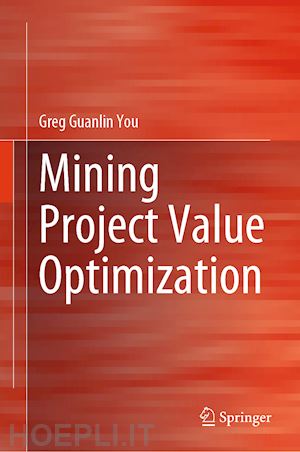
Questo prodotto usufruisce delle SPEDIZIONI GRATIS
selezionando l'opzione Corriere Veloce in fase di ordine.
Pagabile anche con Carta della cultura giovani e del merito, 18App Bonus Cultura e Carta del Docente
This book provides a holistic approach of integrated mine planning and scheduling to optimize mining projects using the discounted cash flow rate of return (DCF-ROR) method. There are nine chapters in the book. Chapter 1 is the Introduction, which provides overviews of mineral assets, minerals in Australia, mineral exploration, mining methods, and significance of valuation, optimization, and integrated mine planning. Chapter 2 is the Mineral Resources and Ore Reserves Estimation, including grade composition method, inverse distance weighting method, ordinary Kriging method and block model. Chapter 3 is the Feasibility Study that delves into three phased feasibility study, namely scoping, prefeasibility and feasibility studies, data requirements, risk identification and mitigation in the feasibility study, and mining project cost estimation. Chapter 4 is the Valuation of Mineral Projects. It starts with the time value of money; followed by methods to calculate cash flow, discounted cash flow (DCF), net present value (NPV), internal rate of return (IRR) and payback period; valuation methods, including market-, income-, and cost-based approaches; and finally the sensitivity study of key factors influencing the valuation of mining projects. Chapter 5 is the Mine Planning and Open Pit Optimization that covers different types of mine planning, block model valuation, Lerchs-Grossmann and floating cone techniques for pit optimization. Chapter 6 is the Life of Mine Optimization that details a case study of strip mining optimization using the DCF-ROR method and integrated LOM optimization of open pit mining. Chapter 7 is the Production Schedule Optimization of Surface Mining, covering production schedule optimization, equipment availability and utilization, and loading and hauling equipment match optimization. Chapter 8 is the Optimization of Underground Mine Planning and Scheduling that delves to a case study of room and pillar mining optimization using the DCF-ROR method and mathematical programs for underground stope layout and production schedule optimization. Chapter 9 is the Conclusion of the book.
The book can benefit students and professionals in multiple ways. Firstly, divisions and confusions may arise from different contexts of technical frameworks, taxation, and relevant legislations in literature. Having quality contents in one book will improve the efficiency of study. Secondly, the inclusion of plentiful hands-on examples and calculation tables underscores the practical application of the concepts, bridging the gap between theoretical knowledge and real-world scenarios. Thirdly, the book adopts an integrated approach to evaluate and optimize mineral projects, utilizing methodologies such as DCF-ROR for optimization, ordinary Kriging for ore reserve estimation, and multi-level optimization including strategic planning, pit optimization, life of mine optimization, and production schedule optimization. Finally, the content is fully aligned with internationally recognized standards such as the VALMIN and JORC codes, ensuring compliance with industry best practices and guidelines.
Introduction.- Mineral Resources and Ore Reserves Estimation.- Feasibility Studies.- Valuation of Mineral Projects.- Mine Planning and Open Pit Optimization.- Life of Mine Optimization of Surface Mining.- Production Schedule Optimization.- Optimization of Underground Mine Planning and Scheduling.- Conclusion.
Dr. Greg Guanlin You specialises in mining and geotechnical engineering design, optimization and risk assessment. He recently completed a CRC TiME project of mine closure planning optimization integrating open pit, waste dump and tailing dam. He supervised six PhD students to completion. He is adept at collaborating with interdisciplinary teams and delivering high impact outcomes to increase safety and productivity. He has published 76 research papers and has spoken at more than 60 seminars and workshops in 13 countries since 2001.
Before joining Federation University Australia in 2006, first as Senior Lecturer and then serving on various roles such as Program Coordinator of Mining Engineering and Stream Leader of the Stable Landforms and Mine Rehabilitation in the FRRC research centre, Greg was Technical Manager of the Asia/Pacific Region at GSE Lining Technology Co. Ltd. He received his PhD in geotechnical engineering from the Asian Institute of Technology, Thailand in 2003.











Il sito utilizza cookie ed altri strumenti di tracciamento che raccolgono informazioni dal dispositivo dell’utente. Oltre ai cookie tecnici ed analitici aggregati, strettamente necessari per il funzionamento di questo sito web, previo consenso dell’utente possono essere installati cookie di profilazione e marketing e cookie dei social media. Cliccando su “Accetto tutti i cookie” saranno attivate tutte le categorie di cookie. Per accettare solo deterninate categorie di cookie, cliccare invece su “Impostazioni cookie”. Chiudendo il banner o continuando a navigare saranno installati solo cookie tecnici. Per maggiori dettagli, consultare la Cookie Policy.